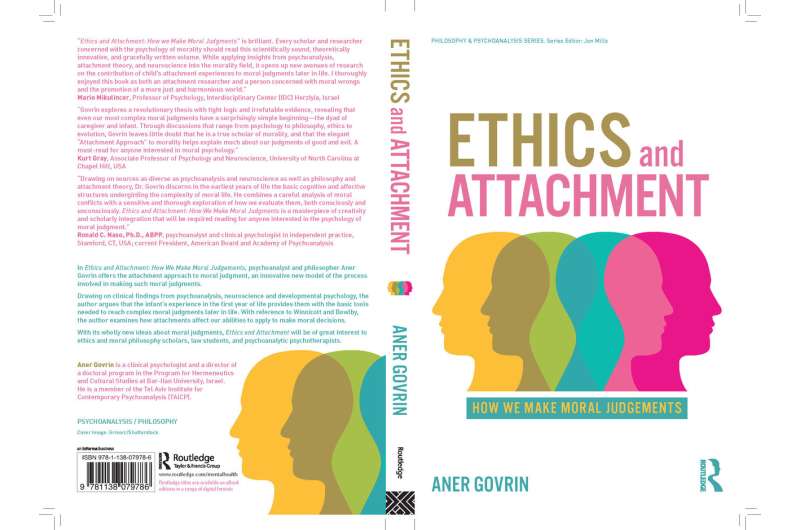New theory of ethics may transform moral psychology

There is consensus among moral psychologists that moral judgment is intuitive and is accomplished by a rapid, automatic, and unconscious psychological process. However, psychologists say little as to what moral intuitions are and how they work: what exactly are the underlying cognitive processes of these judgments that operate quickly, effortlessly and automatically? How are moral situations represented in our minds? What cognitive processes intuitively glue together different moral situations to one category?
In his new book, Ethics and Attachment: How we make moral judgments (Routledge, 2018), Israeli psychologist Aner Govrin, Ph.D., of the Program for Hermeneutics and Cultural Studies at Bar-Ilan University, suggests an innovative framework for understanding moral judgment. His theory, the "attachment approach to moral judgment", combines evidence from research in moral psychology, infant research, and categorization, and then looks at various moral situations to show patterns and regularities. The new theory has the potential to transform moral psychology because it shows for the first time that moral judgment is a computation process, and people from different cultures compute moral judgments in the same manner even though they reach different, and even conflicting, conclusions.
Why does cruelty towards a helpless kitten bother us much more than trampling on ants? Why are we disgusted when an elderly woman is robbed and yet admire Robin Hood? How can it be that people who share a general moral code are poles apart when it comes to judging the morality of abortion or capital punishment? Govrin's book provides an answer to an array of seemingly very divergent and baffling questions such as these.
At their core, says Govrin, moral judgments require us to judge relations between two parties. Moreover, moral judgments are not limited to judging one isolated component of a moral situation, such as intentionality or the extent of harm caused, but rather require an assessment of an entire relationship that is held up to our prior expectations of how relationships of this type should be handled. One of the most important factors in judging relations is assessing the asymmetry of power between the parties.
As part of this assessment we first break down the moral situation into its most basic components. Within the dyad we identify relations between two sides: strong/weak, dependent/independent, helpless/in control. We have a range of expectations as to how the strong party in a dyad should and should not behave towards the weak side. We perceive moral failure when, as observers, we believe that the conduct of the strong towards the weak has violated our expectations.
We represent each of the parties in ways that are comparable to the way we perceive child/adult relationships and, therefore, all our efforts are geared toward constructing the reality of the moral situation in terms of a child—adult dyad. We also evaluate the relationship between the parties. We possess a schema for the dyadic relation, centered on our knowledge of adult obligations to children.
This is why although robbery is in itself deemed wrong, we will unequivocally condemn a thief robbing an elderly woman, but maybe less so someone who defrauds his insurance company, and we might even salute the legendary heroic outlaw Robin Hood. The intent is the same; the action is the same and the damage is the same: an unlawful appropriation of someone else's property. And yet, these are three different dyads with three different relationships between victim and thief, resulting in three different judgments.
This social cognition is universal. We always expect the strong to protect the weak or at least cause him no harm. This expectation stands behind every person's moral judgment in every culture. However, even though the cognitive calculation is universal, our relations towards each of the sides, and sympathy and hostility we feel towards them, constitute an unstable and variable set of factors which differ from person to person and from culture to culture. Thus, suffering per se is not enough to elicit empathy without some attachment to the victim.
And yet, even though they reach contradictory conclusions two observers for and against, say, capital punishment, analyze the moral situation using the same computational process: Detect a dyad, quickly identify the child-like and adult-like components of each party and assess whether and to what extent there was a violation of expectation.
How do we know what to expect from the strong side? According to the theory, this intuitive knowledge is based on our earliest experience, from the first year of life, when we were part of a dyad in which we were the weak side and our life depended on the devotion, care and protection of the stronger side. In the first year a powerful early organizing process takes place which eventually enables the infant to abstract what is common to all moral situations.
Dr. Govrin published a condensed version of the book in 2014 in the scientific journal Frontiers in Psychology.


















